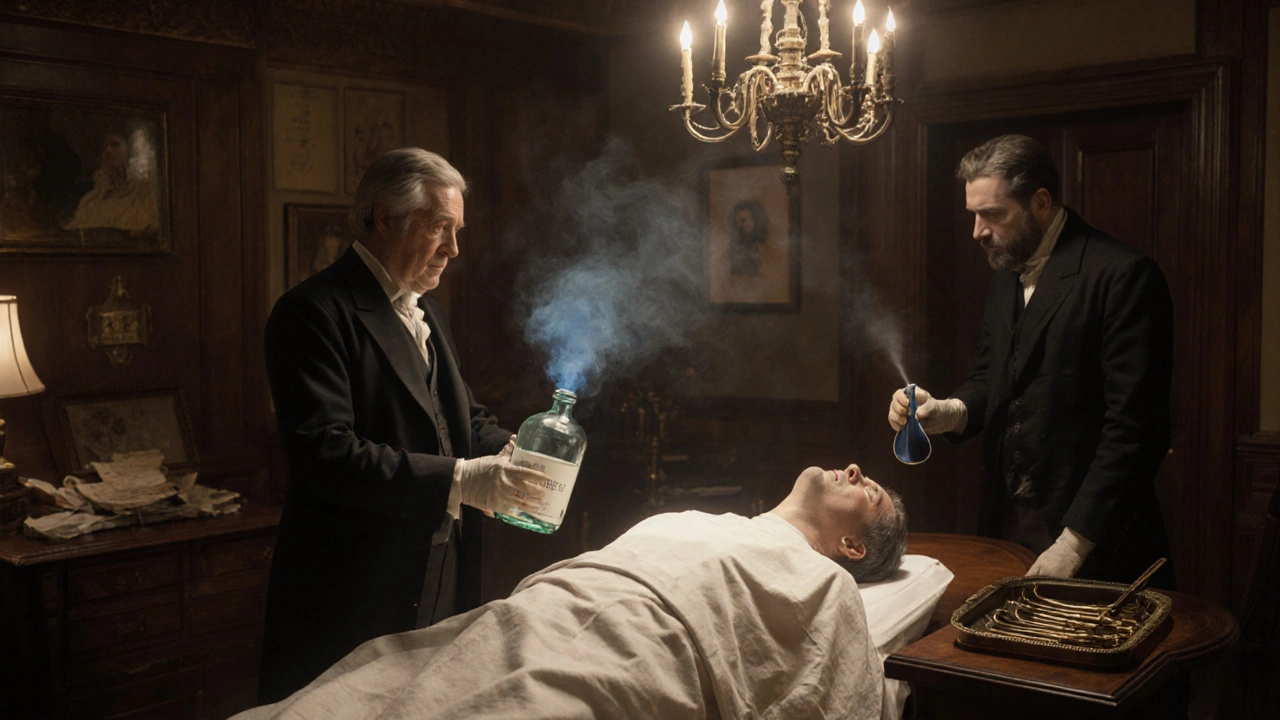History of Minor Surgery Timeline
Key Milestones in Minor Surgery History
Quick Take
- Minor surgery dates back to ancient trepanation, but modern practice began in the 19thcentury.
- Key breakthroughs: anesthesia (1846), antisepsis (1867), and day‑care centers (1970s).
- Today minor procedures include skin lesion removal, cataract extraction, and laser resurfacing.
- Minor surgery reduces hospital stays, cuts costs, and speeds recovery.
- Understanding its history helps clinicians appreciate safety standards and future trends.
Ever wonder why a skin mole can be snipped in an office while a heart bypass still needs a full operating room? The answer lies in a long minor surgery history that turned risky bedside tricks into safe, outpatient routines. Below is a fast‑track tour from stone‑age scalp openings to today’s laser‑assisted clinics.
What Is Minor Surgery?
Minor surgery is a set of surgical procedures that are limited in scope, typically performed under local anesthesia, and do not require an inpatient hospital stay. Common examples include excision of skin lesions, removal of small cysts, and minor orthopedic repairs. The defining traits are short operative time, low physiological stress, and a quick return to daily activities.
Ancient Roots - Trepanation and Early Excision
Archaeologists have uncovered skulls from 7,000BC with circular holes-evidence of trepanation, perhaps the world’s first minor cranial surgery. The goal was often to relieve pressure or treat head trauma, and patients sometimes survived for decades after the procedure.
In ancient Egypt, physicians used bronze scalpels to drain abscesses and excise warts. These early interventions were guided by pragmatic trial‑and‑error rather than sterile technique, yet they set a precedent: many issues could be solved with a quick cut.
Renaissance Leap - AmbroiseParé’s Innovations
Ambroise Paré was a French barber‑surgeon who, in the 1500s, introduced ligature of arteries and cauterization alternatives. His work shifted minor surgery from brutal burning to more precise cutting and stitching.
Paré also documented skin grafts and described how to manage small wounds with simple dressings-principles that echo in today’s outpatient clinics.
19thCentury - Anesthesia and Antisepsis Change the Game
Anesthesia entered the operating theatre in 1846 when William Morton demonstrated ether. With pain no longer a barrier, surgeons could perform longer, more delicate excisions without causing terror.
Antisepsis arrived in 1867 after Joseph Lister championed carbolic acid to sterilize instruments. The combination of painless cuts and clean tools dramatically lowered infection rates, making minor procedures safe enough for office settings.

Early 20thCentury - Rise of Ambulatory Surgery
By the 1920s, physicians in Europe began offering “clinic surgery” for hernias and lipoma removals. The United States followed after WorldII, when advances in antibiotics (penicillin) and blood transfusion simplified post‑op care.
In the 1970s, the term ambulatory surgery was coined to describe procedures that could be completed in a single day without overnight admission. Day‑care centers proliferated, and insurance policies started reimbursing these cost‑effective visits.
Modern Era - Laser, Endoscopic, and Cosmetic Minor Procedures
Laser technology entered clinics in the 1980s, offering precise removal of vascular lesions and tattoo pigments with minimal bleeding.
Endoscopic tools now allow surgeons to perform “keyhole” excisions of small joint problems through a 4‑mm portal, turning what used to be a hospital stay into an office visit.
Cosmetic surgery exploded as patients demanded quick fixes for aesthetic concerns-think Botox injections, micro‑needling, and minimally invasive facelifts-all classified as minor surgery.
Minor Surgery vs. Major Surgery - At a Glance
| Aspect | Minor Surgery | Major Surgery |
|---|---|---|
| Typical Anesthesia | Local or topical | General or regional |
| Setting | Office / outpatient clinic | Hospital operating room |
| Incision Length | <3cm | >3cm, often multiple |
| Recovery Time | Hours to a few days | Days to weeks |
| Typical Cost (US) | $200-$2,000 | $5,000-$50,000+ |
| Risk of Major Complications | Low (infection <1%) | Higher (bleeding, organ injury) |
Key Milestones Timeline
- 7500BC - Trepanation evidence in Neolithic skulls.
- 1540 - AmbroiseParé publishes “The Five Books of Surgery,” introducing ligatures.
- 1846 - First public demonstration of ether anesthesia.
- 1867 - JosephLister publishes antiseptic technique, reducing post‑operative infections.
- 1921 - First clinic‑based hernia repair in Berlin.
- 1945 - Penicillin mass production cuts surgical infection rates.
- 1970 - Ambulatory Surgery Centers (ASCs) proliferate across the U.S.
- 1985 - Introduction of CO₂ laser for dermatologic excision.
- 2000s - Endoscopic instruments enable office‑based joint procedures.
- 2020s - Tele‑consultations triage minor wounds, reducing in‑person visits.
Common Minor Procedures Today
- Skin lesion excision (moles, basal cell carcinoma)
- Cataract removal (phacoemulsification)
- Carpal tunnel release
- Insertion of central venous catheters (peripherally inserted)
- Biopsies of superficial organs (liver, breast)
- Laser resurfacing and tattoo removal
- Minor orthopedic arthroscopy (knee debridement)
Impact on Healthcare Systems
Minor surgery’s shift to outpatient settings has three measurable benefits. First, it cuts inpatient bed usage, freeing rooms for critical care. Second, insurance data show a 30% lower average claim for comparable procedures performed in ASCs versus hospitals. Third, patient satisfaction scores rise because people avoid overnight stays and can return to work within days.
Future trends point toward “virtual minor surgery”: remote pre‑op assessment, AI‑driven wound monitoring, and robotic instruments that fit in a dermatologist’s office. The historical path from scalpels to smart tools suggests the specialty will keep squeezing more value out of fewer resources.

Frequently Asked Questions
What distinguishes minor surgery from a regular office procedure?
Minor surgery involves a surgical incision, tissue removal, or repair, but it is performed with local anesthesia, in an outpatient setting, and usually requires less than a few hours of recovery.
When did anesthesia first make minor procedures painless?
The first public demonstration of ether anesthesia took place in 1846, enabling surgeons to perform longer and more precise minor excisions without causing pain.
Are laser treatments considered minor surgery?
Yes. Laser‑based removal of skin lesions, vascular spots, or tattoos uses focused energy to cut tissue with minimal bleeding, fitting the definition of a minor surgical procedure.
What are the safety advantages of performing minor surgery in an outpatient clinic?
Outpatient clinics enforce strict aseptic protocols, have rapid turnover, and reduce exposure to hospital‑acquired infections. Studies show infection rates below 1% for properly sterilized minor procedures.
How has the history of minor surgery shaped modern day day‑care centers?
Key milestones-anesthesia, antisepsis, antibiotics, and the rise of ambulatory surgery in the 1970s-built the safety and efficiency framework that day‑care centers rely on today, allowing them to perform hundreds of procedures safely each year.


Suraj Midya
October 1, 2025 AT 15:46It’s amazing how the roots of minor surgery stretch back to our own subcontinent, where early healers already practiced trepanation and simple excisions. Those ancient Indian medics understood the value of a quick cut, even if they lacked modern sterility. We should give them credit instead of letting Western narratives dominate. History teaches us that pride in our heritage fuels progress.
Henry Seaton
October 1, 2025 AT 16:46Yeah the early work matters. Simple cuts saved lives. No need to overcomplicate.
Baby Thingie
October 1, 2025 AT 18:10The timeline is largely correct; however, the 1500s entry should reference Paré’s work in the 1560s, not the 1500s broadly. 😊
Lewis Lambert
October 1, 2025 AT 19:33When we talk about the evolution of minor surgery, it's essential to recognize the cascade of innovations that each built upon the last.
Trepanation, as primitive as it sounds, introduced the concept that a controlled breach of tissue could yield therapeutic benefit.
Centuries later, Ambroise Paré's abandonment of cauterization in favor of ligatures fundamentally changed how surgeons approached bleeding, a lesson still taught in medical schools today.
The advent of ether anesthesia in 1846 liberated surgeons from the constraints of patient terror, allowing longer, more precise procedures.
Equally transformative was Lister’s antiseptic protocol, which turned operating rooms from death traps into sterile environments.
These breakthroughs converged in the early 20th century, when outpatient clinics began to perform hernia repairs and lipoma removals without admitting patients.
The post‑World War II era saw antibiotics reduce postoperative infections further, paving the way for day‑care surgical centers in the 1970s.
Laser technology entered the medical field in the 1980s, offering clinicians a tool that could vaporize tissue with minimal collateral damage.
Today’s endoscopic instruments fit through a few millimetres, turning what once required a hospital stay into an office‑based procedure.
Cosmetic minor surgeries, from Botox injections to micro‑needling, exemplify how patient demand drives innovation.
Economically, the shift to ambulatory settings saves healthcare systems billions while delivering faster recovery for patients.
From a sociocultural perspective, the democratization of minor procedures reflects broader trends toward personal autonomy over one’s body.
Ethically, the low risk profile demands stringent training to avoid complacency, because even a tiny incision can become serious if mishandled.
Future directions point toward robotics and AI‑guided micro‑tools that could perform sub‑millimetric excisions without human hands ever touching the skin.
In sum, each milestone-from stone‑age trepanation to AI‑enhanced laser resurfacing-illustrates a relentless pursuit of safety, efficiency, and patient comfort.
Tamara de Vries
October 1, 2025 AT 20:56Love how this piece ties ancient practice to modern tech!
Jordan Schwartz
October 1, 2025 AT 22:20Really insightful! It’s easy to forget how many of today’s conveniences rest on centuries of trial and error.
Nitin Chauhan
October 1, 2025 AT 23:43Keep digging into these histories, they motivate us to push boundaries and improve patient care.
Angelo Truglio
October 2, 2025 AT 01:06Wow!!! This timeline is a roller‑coaster of breakthroughs, from primitive skull‑drilling, to the smoky ether chambers of the 1840s, to the gleaming lasers of the 1980s, and now the sleek endoscopic marvels of today!!! Each era exploded with innovation, each leap reshaped the way we think about “minor” procedures-!!! It’s a symphony of science, courage, and bold experimentation!!! 😱
Xavier Hernandez
October 2, 2025 AT 02:30The saga of minor surgery reads like a vibrant tapestry, each thread dyed with courage, curiosity, and a dash of daring rebellion against the limits of the flesh.
Zach Yeager
October 2, 2025 AT 03:53We should appreciate how cheap these procedures are and how fast they get done it shows progress
Phoebe Chico
October 2, 2025 AT 05:16Isn't it fascinating that a tiny incision can embody the grand dialogue between humanity and its own mortality? In a way, every minor surgery is a quiet conversation where we ask, “How far can we heal without breaking?”